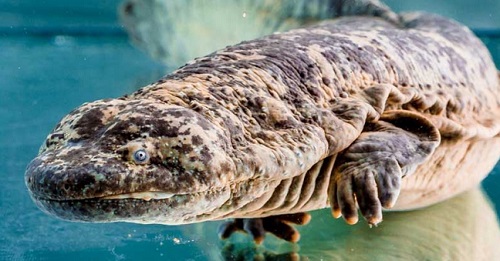Taxonomy
Kingdom |
Phylum |
Class |
Order |
Family |
Genus |
Species |
| Animalia | Chordata | Amphibia | Caudata | Cryptobranchidae | Andrias | Andrias davidianus |
,

Chinese giant salamander from the Prague Zoo
There are 3 species of the Cryptobranchidae family: Chinese giant salamander, Japanese giant salamander and North America Hellbender.
Name
- Common name: Chinese giant salamander.
- Scientific name: Andrias davidianus.
Distribution and Habitat
- The Chinese giant salamander is an amphibian endemic to China.
- Its native range covered central, south west and south China. Before the 1970s its distribution was widespread along the Yangtze, Yellow and Pearl Rivers.
- Today its distribution is fragmented due to urbanization, industrial and agricultural development, pollution, and poaching.
- It was introduced to Taiwan.
- The Chinese giant salamander lives and breeds in freshwater mountain rivers and large streams in forested areas.
- They prefer rocky or gravel bottoms and river banks with scrub vegetation and high water flow at an altitude of 656 to 6.561 feet or 200 to 2,000 meters above sea level.

Chinese giant salamander distribution map. Source: IUCN Red List of Threatened Species.
Physical Features
- The Chinese giant salamander is the largest living amphibian in the world. They can reach lengths of up to 5.9 feet or 1.8 meters. On average they measure 3.28 feet or 1 meter in length. At present time larger individuals are more difficult to find.
- They have a cylindrical body shape.
- Its head is wide, round and flat with small eyes with no eyelids.
- They have short limbs with 5 toes on the hind limbs and 4 in the fore limbs.
- Like all amphibians its skin lacks scales. Its skin is dark brown, dark green or black with irregular blotches. It is rough and wrinkled with folds and tubercles.
- It breathes through its porous skin which folds along its flanks and its gill slits.
- Larvae do have gills which they lose after they metamorphose, however its metamorphosis is incomplete as they retain gill slits.
- The location of its tubercles distinguishes the Chinese giant salamander from its cousin the Japanese salamander. The Chinese salamander has tubercles on its head and throat, 2 small ones parallel to the lower jaw.
- Its tail is 60% of its body length.
Behavior
- The Chinese giant salamander is completely aquatic, spends its live in water.
- They are more active at night.
- They live in hollows and cavities underwater.
- These salamanders produce sounds like a baby’s cry therefore it is commonly called baby fish.
Diet
- Chinese giant salamanders eat fish, salamanders, aquatic insects, crayfish, snakes, worms, crabs and shrimps.
- They feed by suction.
Reproduction
- Both males and females reach reproductive maturity at 5 years old.
- During mating season in August and September they travel upstream.
- Females lay approximately 500 eggs in a string and deposit them in a cavity or hollow underwater inhabited by a male. The male externally fertilizes the eggs and guards them against intruders until they hatch.
- Eggs hatch in about 50 to 60 days after they were fertilized.
- Larvae start eating after 30 days during that time they live from stored fat. They start hunting as a group.
- There is no parental care.
Life Expectancy
- Chinese giant salamanders are the amphibians with the longest lifespan.
- In captivity they live up to 55 years.
- In the wild it has been reported that they can live up to 80 years.
Threats
- There has been a drastic population decline estimated at 80% over the last 50 years.
- The Chinese giant salamander has been used in Chinese traditional medicine and food for centuries.
- Destruction of habitat due to construction of dams, pollution, industrial, agricultural and urban development has exacerbated its decline.
- As a carnivore animal the Chinese giant salamander is important in maintaining the balance of its ecosystem.
Conservation Status
- China has 38 reserves focusing on this species.
- The Chinese giant salamander is protected under Cites Appendix I.
- It is listed in the IUCN Red list of Threatened Species as “critically endangered”.
Did you know?
- Fossils of this family date back to 65 million years ago. Chinese giant salamanders are considered living fossils that lived in the same period as dinosaurs.
- The study of amphibians is called batrachology.
References and additional research
American Museum of Natural History – Amphibian Species of the World, an online Reference
IUCN Red List of Threatened Species – Andrias Davidianus
